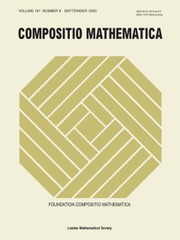Article contents
The algebra of cell-zeta values
Published online by Cambridge University Press: 10 March 2010
Abstract
In this paper, we introduce cell-forms on 𝔐0,n, which are top-dimensional differential forms diverging along the boundary of exactly one cell (connected component) of the real moduli space 𝔐0,n(ℝ). We show that the cell-forms generate the top-dimensional cohomology group of 𝔐0,n, so that there is a natural duality between cells and cell-forms. In the heart of the paper, we determine an explicit basis for the subspace of differential forms which converge along a given cell X. The elements of this basis are called insertion forms; their integrals over X are real numbers, called cell-zeta values, which generate a ℚ-algebra called the cell-zeta algebra. By a result of F. Brown, the cell-zeta algebra is equal to the algebra of multizeta values. The cell-zeta values satisfy a family of simple quadratic relations coming from the geometry of moduli spaces, which leads to a natural definition of a formal version of the cell-zeta algebra, conjecturally isomorphic to the formal multizeta algebra defined by the much-studied double shuffle relations.
MSC classification
Information
- Type
- Research Article
- Information
- Copyright
- Copyright © Foundation Compositio Mathematica 2010
References
- 8
- Cited by

